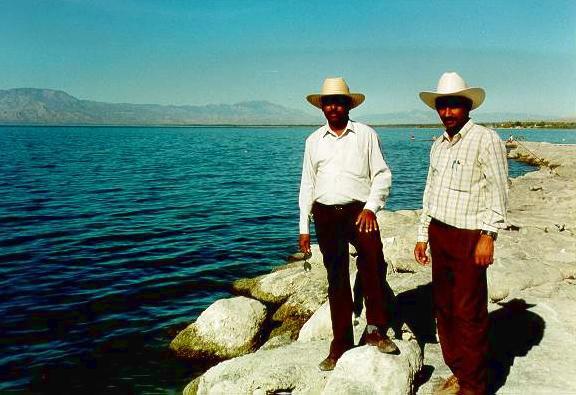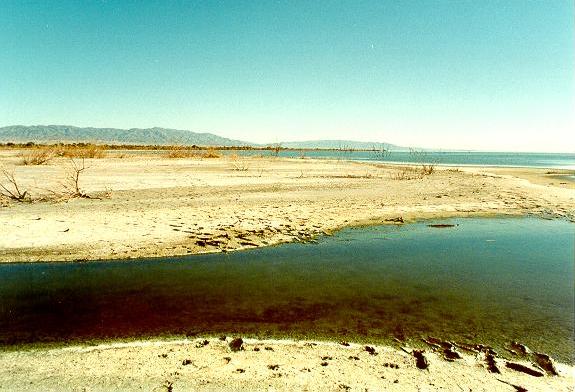|
|
CIVE 633 - ENVIRONMENTAL HYDROLOGY
RESTORATION OF THE SALTON SEA
|
|
Click -here- for printable copy.
|
- The Salton Sea is the largest lake in California.
- It encompasses 979 km2.
- The south shore of the lake is approximately 40 km north of El Centro.
- The lake is below sea level, filling a depression known as the Salton Sink, with its deepest point at -84.7 m
below mean sea level.

- In the geologic past, the Salton Sea was part of the Gulf of California, but it became separated from it due to
sediment deposition in the Colorado river delta.
- Mean annual precipitation is 57.9 mm.
- Mean annual evaporation is 1798 mm.
- In the absence of artificial inflows, the lake has a tendency to dry up naturally.
Creation of the Sea
- In the spring of 1905, a diversion of the Colorado river south of the U.S.-Mexico border failed during flood
conditions.
- For almost two years, the entire flow of the Colorado river flowed into the Salton Sink, filling it to -59.4 m,
with a surface area of 1347 km2.
- The lake level decreased, reaching an all-time low of -76.2 m in the early 1920's.
- Since then, agricultural activity has expanded in the valley.
- In 1928, an Executive Order designed lands within the Salton Basin below -67.05 as storage for wastes and seepage
water from irrigated lands in the Imperial valley.
- Since then, the use of the Salton Sea as a repository for agricultural wastewater has led to increased inflows to the
lake.
- In the past 70 years, the lake level has increased gradually to its present (1998) level of -69.2 m.
- In 1907, after formation, the salinity of the Salton Sea was 3.5 ppt (3500 ppm).
- Salinity increased afterwards, reaching 37.6 ppt (37600 ppm) in 1923.
- Salinity now exceeds 44 ppt (44000 ppm).
- In the past 15 years, the rate of increase of salinity has been 0.43 ppt yr-1.
- At this rate, it is expected that the lake will become totally unfit for fisheries biota by the year 2010.
- The restoration must accomplish the following objectives:
- Reduce the salinity to that of the oceans (34500 ppm) to preserve the lake's biological and recreational resources.
- Decrease the lake level to the more manageable range of -70.1 to -71.6 m to control flooding and ensure that the lake
level remains beyond the legal permissible limit (not higher than -67.05 m).
- The recognition that the Salton Sea is in ecological trouble is not new.
- Initially, the Salton Sea supported a community of freshwater fishes which came with the Colorado river floodwater.
- As salinity increased through the years, the original freshwater fish disappeared.
- Between 1929 and 1956, the California Department of Fish and Game made numerous transplants of both fish
and invertebrates with the aim of developing a sport fisheries in the sea.
- Of the numerous species intentionally transplanted, only the pileworm, mudsucker, and three sport fish
(corvina, sargo, and bairdiella) survived.
- No spawning occurred at salinities of 45 to 50 ppt.
- Most game fish will disappear at salinities above 50 ppt.
- Salton Sea is in the flyway of numerous migrating and wintering bird species, particularly waterbirds.
- The latter represent the higher trophic levels of food webs in the Salton Sea and surrounding areas.
Irrigation needs
- Irrigation is needed to support intensive agriculture in the Imperial and Coachella valleys.
- The agricultural wastewater is discharged into the Salton Sea through the drainage network.
- Anthropogenic inflows account for 96.7% of inflows to the sea.
- The Salton basin is endorheic, with three major rivers: the Alamo, New, and Whitewater.
- The Alamo and New drain the Imperial and Mexicali valleys to the south.
- The Whitewater drains the Coachella valley to the north.

- Together, these streams account for 85% of the inflows.
- Sodium (Na+), chloride (Cl-) and sulfate (SO4-) ions
constitute about 93% of the total salinity.
- Water evaporates and leaves behind the salt ions.
- The salinity of Colorado river water has been measured at 0.787 ppt (787 ppm).
- As the imported water flows through the irrigation system, the salinity increases due to the following reasons:
- Leaching of the salts brought with the irrigation water (imported salt)
- Leaching of salts due to excessive application of fertilizers (anthropogenic salt)
- Leaching of salts already available in the soil profile (old or fossil salt).
- Leaching of salts produced by the normal weathering of soil minerals, exacerbated by the irrigation process
(new or current salt)
- Over the past several decades, expanding agricultural activities has led to increased wastewater inflows
to the Salton Sea.

- The gradual rise in lake level has led to local flooding.
- In the past 40 years, the lake level has risen by 2.44 m to the present -69.2 m.
- If this rate is linearly extrapolated, the lake may reach its legal limit in about 35 years.
- Recent data indicate that the lake may be close to achieving a hydrologic equilibrium (inflows equal to evaporation).
- Agriculture is important to the region's economic prosperity, and that of California and the United States.
- There are 186,000 ha of irrigated land in the Imperial valley, and 24,200 in the Coachella valley.
- MOREOVER, THE REGION IS A MAJOR PRODUCER OF WINTER CROPS IN THE UNITED STATES.
- The agricultural production of the two valleys amounts to 1.3 billion dollars.
- The lake cannot exist without inflows from agricultural drainage, which provide the much needed water.
- These inflows are loaded with dissolved ions, which are degrading the lake and impairing its other uses.
- Issue of geology, physics, chemistry, biology, ecology, agriculture, and economics are intertwined.
- Salinity must be reduce to ocean level.
- Salts have to be removed at the rate of 0.85 ppt yr-1
- The salts to be removed amount to 8.16 million metric tons yr-1.
- After the 30-yr restoration period, the salts to be removed are about half of this amount.
- Restoration is energy intensive.
- Solar and geothermal energy is already available.
- More than 50 proposals have been advanced to restore the sea.
- The 1998 USBR study narrowed the list to five types of diked impoundment.
- The diked impoundment would concentrate the salts in an enclosed portion of the lake, creating an hypersaline lake.
- Water is expected to flow by gravity to the impoundment, eventually decreasing the salinity of the lake to ocean level.
- This alternative will degrade 1/7 of the lake to restore the health of the remaining 6/7.
- As the salinity of the diked impoundment increases, its evaporation rate will decrease.
- Research has shown conclusively that evaporation rates vary with salinity and temperature.
- For example, a brine with 400 ppt will evaporate at rates varying from 5 to 26% of that of freshwater.
- The reduced evaporation will effectively raise water levels.
- The proposal (approved) to sell 200,000 ac-ft annually to San Diego will result in a corresponding decrease in lake inflows.
- This assures that the dike impoundment solution will not work.
- A proposal to restore the Salton Sea using solar still distillation is presented.
- The products of distillation are water of high purity and a highly concentrated brine.
- Distillating 75% of the water will concentrate the 47% brine to 188 ppt, with a specific gravity of 1.15.
- The water lost in the distillation process (25%) amounts to 3% of the lake inflow.
- Evaporation ponds will be needed to reduce the brine to exportable salt.
- The extracted salts can be transported out of the region for ultimate disposal in the high seas.
- The distilled water may be returned directly to the sea.
- If the lake is increasing, a fraction of the distilled water may be commercialized to control lake level.
- Solar distillation has the following advantages:
- It helps reduce the lake level to a more manageable range.
- It can be operated for unlimited periods.
- It does not degrade lake surface area.
- Solar distillation is a feasible alternative to restore the Salton Sea.
- Solar distillation has the following advantages:
- It is environmentally friendly.
- It is sustainable, because it can be operated for unlimited periods.
- It is holistic because it does not degrade surface area.
- The diked impoundment alternative has been abandoned by the Salton Sea Authority as of 2001.
- Monies have been made available recently (October 2002) by the state to continue to "study" the problem.
- More monies (at least 1 billion) will be required to clean the Salton Sea.
- Who will pay? IVC? The state of California? The federal government?
- The almost sure transfer of 200,000 ac-ft of water annually
to San Diego County will have to be accounted for in any restoration effort or project.
- Current agreements postpone the problem for 15 years, buying time so that more studies and knowledge become available.
|